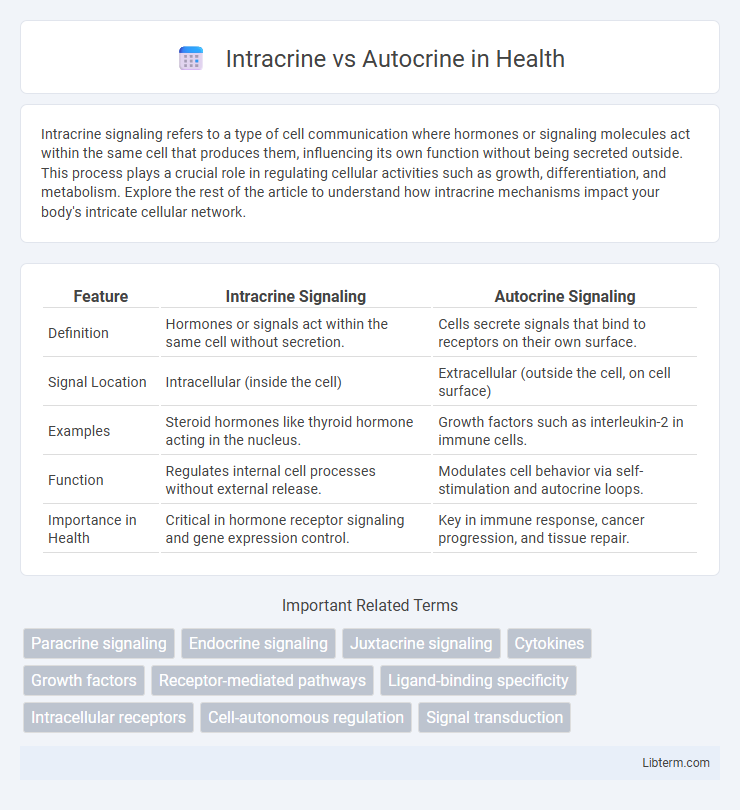Intracrine signaling refers to a type of cell communication where hormones or signaling molecules act within the same cell that produces them, influencing its own function without being secreted outside. This process plays a crucial role in regulating cellular activities such as growth, differentiation, and metabolism. Explore the rest of the article to understand how intracrine mechanisms impact your body's intricate cellular network.
Table of Comparison
| Feature | Intracrine Signaling | Autocrine Signaling |
|---|---|---|
| Definition | Hormones or signals act within the same cell without secretion. | Cells secrete signals that bind to receptors on their own surface. |
| Signal Location | Intracellular (inside the cell) | Extracellular (outside the cell, on cell surface) |
| Examples | Steroid hormones like thyroid hormone acting in the nucleus. | Growth factors such as interleukin-2 in immune cells. |
| Function | Regulates internal cell processes without external release. | Modulates cell behavior via self-stimulation and autocrine loops. |
| Importance in Health | Critical in hormone receptor signaling and gene expression control. | Key in immune response, cancer progression, and tissue repair. |
Introduction to Cell Signaling: Intracrine and Autocrine Pathways
Intracrine signaling involves hormones or signaling molecules that act within the same cell that produces them, directly affecting intracellular targets without secretion. Autocrine signaling occurs when a cell releases signaling molecules that bind to receptors on its own surface, triggering a response in the same cell. Both pathways play essential roles in regulating cellular processes such as growth, differentiation, and homeostasis in cell signaling mechanisms.
Defining Intracrine Signaling: Mechanisms and Functions
Intracrine signaling involves hormones or signaling molecules acting within the same cell that produces them, bypassing extracellular release and receptor binding on the cell surface. This mechanism regulates gene expression and intracellular pathways by direct interaction with nuclear or cytoplasmic receptors, influencing processes such as cell growth, differentiation, and apoptosis. Unlike autocrine signaling, which involves ligand secretion and re-binding to cell surface receptors, intracrine signaling remains confined intracellularly, ensuring precise and localized modulation of cellular functions.
Understanding Autocrine Signaling: Key Features
Autocrine signaling involves cells releasing signaling molecules that bind to receptors on their own surface, enabling self-regulation of cellular functions such as growth and differentiation. This process plays a crucial role in immune responses and cancer progression by modulating cell proliferation and survival. Key features include localized molecule release, receptor specificity, and rapid feedback mechanisms that maintain cellular homeostasis.
Molecular Pathways: Intracrine vs Autocrine
Intracrine signaling involves hormones or molecules acting within the same cell without being secreted, directly influencing intracellular molecular pathways such as nuclear receptor activation and gene transcription regulation. Autocrine signaling occurs when cells secrete signaling molecules like cytokines or growth factors that bind to receptors on their own surface, triggering pathways such as MAPK, PI3K/Akt, and JAK/STAT to modulate cell proliferation and survival. Distinct molecular mechanisms differentiate these pathways, with intracrine signals bypassing extracellular space and autocrine signals relying on receptor-mediated signal transduction at the plasma membrane.
Intracrine Signaling in Physiology and Disease
Intracrine signaling involves the action of hormones or signaling molecules within the same cell where they are synthesized, regulating intracellular processes without secretion. This mode of signaling plays a crucial role in cellular homeostasis, gene expression, and apoptosis, particularly in endocrine and cancer cell physiology. Dysregulation of intracrine pathways contributes to diseases such as hormone-dependent cancers, where aberrant intracellular hormone receptor interactions drive tumor progression.
Autocrine Signaling in Cellular Regulation
Autocrine signaling plays a critical role in cellular regulation by enabling cells to respond to signals they themselves secrete, creating a feedback loop that tightly controls processes such as growth, differentiation, and apoptosis. This type of signaling is essential in immune responses, where T cells release cytokines that bind to their own receptors to modulate activation and proliferation. Dysregulation of autocrine signaling pathways often contributes to diseases like cancer, making them key targets for therapeutic intervention.
Key Differences Between Intracrine and Autocrine Mechanisms
Intracrine signaling involves hormones or molecules acting within the same cell that produces them, directly influencing intracellular processes without being secreted, whereas autocrine signaling occurs when a cell secretes signaling molecules that bind to receptors on its own surface, triggering external membrane-bound receptor pathways. Intracrine mechanisms are crucial in regulating gene expression and intracellular enzyme activity, while autocrine pathways commonly modulate cell growth, immune responses, and inflammation through receptor-mediated signaling cascades. The key difference lies in intracrine signaling's intracellular action versus autocrine signaling's extracellular receptor interaction.
Shared Pathways and Overlapping Functions
Intracrine and autocrine signaling both utilize shared pathways such as receptor tyrosine kinases (RTKs) and MAPK/ERK cascades to regulate cellular functions including proliferation, differentiation, and apoptosis. These overlapping functions enable cells to fine-tune responses through internal hormone action in intracrine signaling and extracellular ligand-receptor interactions in autocrine signaling. The convergence of signaling molecules like growth factors and cytokines illustrates the integrated network governing cell growth and immune responses.
Clinical Implications: Targeting Intracrine and Autocrine Signals
Targeting intracrine and autocrine signaling pathways offers promising strategies for precision oncology and endocrine disorders by modulating intracellular hormone or growth factor activity unique to these mechanisms. Inhibitors that selectively disrupt intracrine hormone synthesis or autocrine receptor-ligand interactions can improve therapeutic specificity, reduce off-target effects, and overcome resistance seen in conventional endocrine or growth factor receptor targeting. Clinical trials assessing intracrine enzyme blockers and autocrine receptor antagonists report enhanced efficacy in hormone-driven cancers such as breast and prostate malignancies.
Future Research Directions in Cell Communication
Future research in cell communication will explore the distinct signaling pathways and receptor interactions that differentiate intracrine from autocrine mechanisms, enhancing targeted drug development. Advances in single-cell sequencing and live-cell imaging technologies are expected to elucidate intracellular hormone action and extracellular ligand signaling with unprecedented precision. Investigating the crosstalk between intracrine and autocrine systems could reveal novel therapeutic targets for diseases such as cancer and metabolic disorders.
Intracrine Infographic

 libterm.com
libterm.com